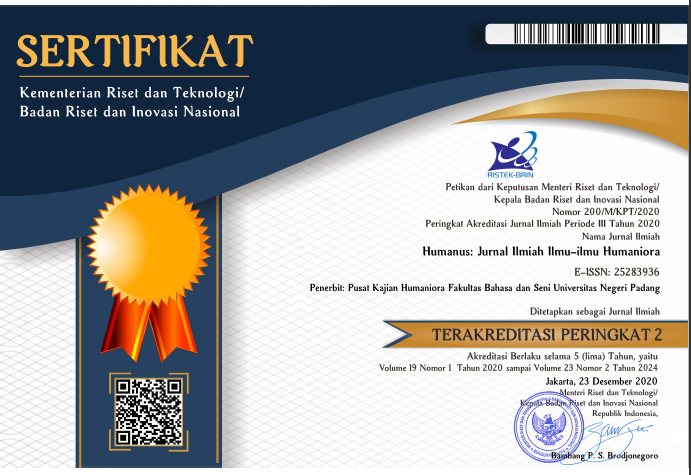Opposing The Construction of Femininity in Неделя Как и Любой Другой by Natalya Baranskaya
 ),
), (1) Universitas Indonesia
(2) Universitas Indonesia
 Corresponding Author
Corresponding Author
Copyright (c) 2024 Kumara Anggita, Mina Elfira
DOI : https://doi.org/10.24036/humanus.v23i1.125675
Full Text:
 Language : en
Language : en
Abstract
Keywords
References
Baranskya. N. (n.d). Наталья Баранская, Неделя как неделя 1969. Wmmsk. Accessed on March 25, 2024 from https://www.wmmsk.com/Library/%D0%96%D0%B5%D0%BD%D1%81%D0%BA%D0%B0%D1%8F%20%D0%BB%D0%B8%D1%82%D0%B5%D1%80%D0%B0%D1%82%D1%83%D1%80%D0%B0/%D0%9D%D0%B0%D1%82%D0%B0%D0%BB%D1%8C%D1%8F%20%D0%91%D0%B0%D1%80%D0%B0%D0%BD%D1%81%D0%BA%D0%B0%D1%8F,%20%D0%9D%D0%B5%D0%B4%D0%B5%D0%BB%D1%8F%20%D0%BA%D0%B0%D0%BA%20%D0%BD%D0%B5%D0%B4%D0%B5%D0%BB%D1%8F%201969.pdf
Davis, N. Y. (1997). Gender and Nation. New York: London
de Beauvoir, S. (1953). The Second Sex. New York: Knopf.
Elfira, M. (2002). Perempuan Rusia pada Era Komunisme: Studi Kritis terhadap Karya-karya Terbaik A.M Kollontai dan N.V Baranskaia. Fakultas Ilmu Pengetahuan Budaya Universitas Indonesia.
Elfira, M. (2012). Sastra dan Masyarakat Rusia. Jakarta: Padasan.
Elfira, M. (2007). Membedah Keterlibatan Negara dan Masyarakat Rusia dalam Persoalan Gender, Seks, dan Famili pada Masa dan Pasca Uni Soviet. Wacana, Journal of the Humanities of Indonesia: Vol. 9: No. 1, article 11.
Encyclopedia.com. (n.d.). Union of Soviet Socialist Republics. Retrieved from https://www.encyclopedia.com/places/commonwealth-independent-states-and-baltic-nations/cis-and-baltic-political-geography/union-soviet-socialist-republics
FǍtu-Tutoveanu, A. (2010). Constructing Female Identity in Soviet Art in The 1930. Bulletin of the Transilvania University of Brasov, Series IV: Philology & Cultural Studies, 3(52)
Tong, R. P. (2017). Feminist Thought. Yogyakarta: Jalasutra.
Ghodsee, K. R., & Mead, J. (2012). What Has Socialism Ever Done for Women. Catalyst, 2.
Lapidus, G. W. (1978). Women in Soviet Society: Equality, Development, and Social Change. University of California Press: London.
McLaughlin, S. (1989). The Image of Women in Contemporary Soviet Fiction. Houndmills, Basingstoke, Hampshire RG21 2XS and London: MacMillan.
Kruks, S., Rapp, R., & Young, M. B. (1989). Promissory Notes: Women in The Transition to Socialism. New York: Monthly Review Press.
McLaughin, T. (1989). Ltetarture: The Power of Language. San Diego, New York, Chicago, Austin
Peri. (2018). New Soviet Woman: The Post- World War II Feminine Ideal at Home and Abroad. The Russian Review.
Rubin, G. (1975). The Traffic in Women: Notes on the 'Political Economy' of Sex. In R. R. Reiter, Toward an Anthropology of Women. New York: Monthly Review Press.
Rutchild, R. (1983). Sisterhood and Socialism: The Soviet Feminist Movement. A Journal of Women Studies, 7, 4-12.
Suny, R. G. (1998). The Soviet Experiment: Russia, the USSR, and the Successor States. New York: Oxford University Press.
Taylor, S. J., Bogdan, R., & DeVault, M. L. (2015). Introduction to qualitative research methods: A guidebook and resource. John Wiley & Sons
Tay, A. E.-S. (1972). The Status of Women in the Soviet Union. The American Journal of Comparative Law.
Ten Brink, J. (2004). Robespierre and the Red Terror. Hutchinson & Co: London.
Toha-Sarumpaet, R. K., & Budianta, M. (2010). Rona Budaya: Festschrift untuk Sapardi Djoko Damono. Yayasan Pustaka Obor Indonesia.
Tutovanu, A. F. (2015). Constructing Female Identity in Soviet Art in the 1930s: A Case Study: Vera Mukhina's Sculpture. Bulletin of the Transilvania University of Brașov.
Walby, S. (1990). Theorizing Patriarchy. Blackwell: Oxford.
Widyastuti, T. (2015). Representasi Perempuan dalam Неделя Как и Любой Другой karya Natalya Baranskaya. Jurnal Sastra dan Solidaritas Bangsa
Zavalloni, M., & Moscovici, S. (1969). The group as a polarizer of attitudes. Journal of Personality and Social Psychology, 12, 125-135.
 Article Metrics
Article Metrics
 Abstract Views : 189 times
Abstract Views : 189 times
 PDF Downloaded : 63 times
PDF Downloaded : 63 times
Refbacks
- There are currently no refbacks.
Copyright (c) 2024 Kumara Anggita, Mina Elfira

This work is licensed under a Creative Commons Attribution-NonCommercial 4.0 International License.










